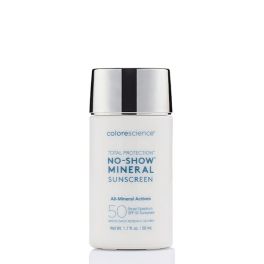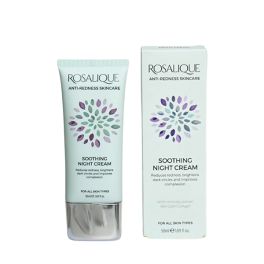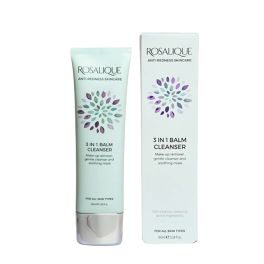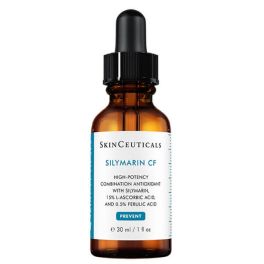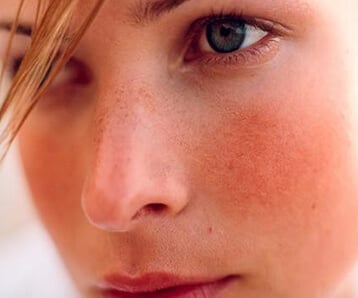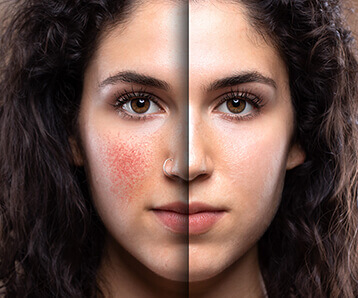About Rosacea Posted on 25 Jul 2018
Source: Jan Marini
Rosacea is a skin disorder that affects approximately 13 million Americans. Physicians and skin care professionals are seeing rapidly increasing numbers of individuals affected by rosacea as the "over 40" population continues to grow. Rosacea is also gaining general public awareness as evidenced by the designation of March as "National Rosacea Awareness Month." This often baffling disease can be difficult to treat and can cause severe emotional distress due to the visible facial involvement.
The disease rosacea was originally called "acne rosacea." That name is no longer considered correct. Even though many aspects of rosacea may closely mimic the description and characteristics of acne, it is a completely separate entity. Rosacea is a common, chronic inflammatory disorder, usually affecting the central portion of the face and occasionally the V-shaped area of the chest, the back, and even the scalp. It is characterized by facial redness, telangiectasia (dilated capillaries), and sometimes lesions that look like acne papules and pustules. It is often difficult to diagnose rosacea because the lesions can so closely resemble acne. However, even though a rosacea papule or pustule may imitate acne, the key differentiation is that in rosacea, no microcomedone activity is present.
Most commonly, the clinical onset of rosacea begins between ages 30 and 50 years, but it can occur in adolescence or in the elderly. Also, rosacea is much more prevalent among females; but, when men get rosacea, it is usually far more severe. Lastly, there is a much higher incidence of rosacea in fair-skinned individuals.
IMPORTANT FACTS ABOUT ROSACEA
• Rosacea is not acne, but it can be present at the same time as acne.
• Rosacea is a progressive disease and must be taken seriously.
• Rosacea is not just sensitive or "cuperose" skin.
What causes Rosacea?
It's not known for certain what causes rosacea. However, there are a number of prominent theories. The most common theory is that rosacea is caused or aggravated by a microscopic pest known as the demodex mite (domox fulliculoneum).²Other theories include gastrointestinal disease or possible lesions on the hypothalamus gland. However, none of these theories are proven. Recent research indicates that the cause of rosacea may involve a variety of possibilities and that the factors causing or exacerbating rosacea can vary greatly from person to person.
New data has identified factors that trigger certain symptoms associated with rosacea. Everyone has responses to inflammatory triggers, which are considered not only normal but necessary. However, it has been determined that individuals with rosacea express abnormally high levels of a protein referred to as "catheliciden."³ Cathelicidens assist in killing microbes and also are critical in signaling inflammatory responses. Production of abnormally high levels of catheliciden peptides appears to cause the skin to react as though there is an inflammatory threat even though one may not be present. This may be an important factor as to why individuals with rosacea exhibit erythema and vascular dilation.
The only absolute certainty is that cumulative sun exposure and resulting sun damage always play a major role in the development of rosacea. Sun damage decreases the integrity of dermal connective tissues, which then allows for passive dilation of blood vessels.
Stages of Rosacea (How the disease progresses)
Pre-Stage I Rosacea
It is believed that some individuals may be predisposed to developing rosacea either because of hereditary factors or certain innate characteristics that they possess. These people tend to show early signs that may indicate the tendency to develop rosacea. While these signs do not guarantee that they will develop rosacea, at the very least, precautionary measures can be initiated that may assist in delaying or preventing the actual onset of the disease, or more effectively control the outward symptoms. Persons who may have pre-stage I rosacea are often referred to as "flushers and blushers." For example, a young woman in her early 20s might have a glass of wine, eat spicy food or become emotional. Instead of a possible momentary flush, her face, neck and chest may turn red and the redness might persist for 10-30 minutes. In people who develop rosacea, reactive flushing and blushing eventually leads to permanent erythema (redness).
Stage I Rosacea/Erythematotelangiectatic Rosacea (persistent moderate erythema)
The most common characteristics of stage I rosacea is persistent redness. While this erythema (redness) may be intermittent, it is usually present for hours or days at a time. Capillaries dilate and form vascular spray-like designs on the nose, nasolabial folds, and cheeks. The skin may become more sensitive and may react to certain cosmetics. In addition, the skin is more reactive to most physical and chemical stimuli.
Stage II Rosacea/Papulopustular Rosacea (persistent erythema, numerous telangectases papules and pustules)
Stage II rosacea includes the outward characteristics of stage I, along with acne-like papules and pustules. These lesions can be present intermittently or may persist for weeks at a time. Once again, it is important to remember that these are not actual acne lesions. The deeper inflammatory rosacea lesions can produce shallow scars.
As stage II progresses, the sebaceous follicles become larger and more prominent, further contributing to the formation of papules and pustules. It is also important to note that pustules and papules are a result of inflammatory causes and not bacteria. The larger lesions contribute more to shallow scarring, further adding to the devastating effect that rosacea can have on the patient's self-image.
Stage III Rosacea/Severe Papulopustular Rosacea (persistent deep erythema, dense numerous telangectases that form sprays or vessels, especially in the nose area, papules, pustules and nodules with variable plaque-like edema)
Generally, only a small number of individuals will progress to stage III rosacea. In stage III, patients exhibit all of the characteristics of stages I and II, along with a gradual deformatory of facial features. As stage III progresses, facial features may become thicker, coarser and irregular. The sebaceous glands continue toward extreme enlargement, contributing further to extensive large inflammatory nodules. The appearance of someone with stage III rosacea can be similar to individuals exhibiting the most severe cystic acne.
Variations of Rosacea
Ophthalmic Rosacea
It is not uncommon for the eyes to be involved with rosacea. The signs of ophthalmic rosacea may include persistent redness, itching, swelling, inflamed and crusting eyelids, and light sensitivity. Usually ophthalmic rosacea responds well to treatment. However, it is important to seek early diagnosis and treatment to avoid possible complications. It is possible for extreme cases of untreated ophthalmic rosacea to lead to blindness.
Rosacea Conglobata
This form of rosacea is relatively rare. It occurs mainly in females. The disease is generally limited to the face and mimics the appearance of severe disfiguring acne.
Rosacea Fulminans
This variation is possibly the most extreme form of rosacea. Rosacea fulminans only occurs in women. It is characterized by its very rapid onset, often reaching the peak of severity within only days to weeks. Lesions form in the appearance of giant abscesses and multiple lesions and the resulting disfigurement is hideous. Even though rosacea fulminans is so disfiguring and debilitating, the prognosis is excellent. Typically the disease is treated with Accutane™ and steroids. Once rosacea fulminans is under control, it does not recur.
Steroid Rosacea
Steroid rosacea occurs when an individual has been treated for extended periods of time with topical steroids, such as cortisone-type creams. Usually, this is a patient who started out with stage I rosacea and was treated for the persistent redness with a topical steroid cream. Topical steroid medications should be used for short duration only. Unfortunately, when long-term topical steroid treatment is discontinued, one side effect is a marked worsening of the very rosacea characteristics that the medication was intended to address. Steroid rosacea is often difficult to treat because the disease becomes even more pronounced when the physician tries to eliminate the topical steroid.
Rhinophyma
This variation generally occurs only in men. The most common visual characteristic is an extremely bulbous nose that becomes progressively larger over many years. A common misconception is that rhinophyma is caused by excessive alcohol consumption and the disease is often associated with alcoholics. Alcohol does not cause rhinophyma. As with any form of rosacea, alcohol can exacerbate many of the symptoms, but other perhaps unknown factors are the causative issue.
There are also a number of rhinophyma variations that include:
• Glandular Form
• Febrous Form
• Febroangiomatous Form
• Actenic Form
Things to remember about Rosacea:
• Rosacea is not curable.
• Rosacea is treatable and can be controlled.
• Rosacea is varied and complex.
• Treatment requires dedication and perseverance.
• Diet must be considered.
• The patient must be compliant and flexible.
• Broad-spectrum sunscreen is an absolute must.
• Rosacea is difficult to treat because there is no one specific target organism or cause.
Rosacea treatment options
General at-home care:
• Patients should avoid all known irritants and sources of local irritation.
• Broad-spectrum sunscreen is an absolute must.
• Topical prescription products should be in a non-alcohol base.
• Prescription Topical Treatment
• Topical Metronidazole (Metro-Gel™)
• Available in gel, lotion & cream at 0.75% Excellent results
• Part anti-inflammatory, part insecticide, part antibacterial
• Topical Noritate
• 1% Metronidazole in a cream formulation
• Topical Klaron™ (Sodium Sulfacetamide Lotion)
• Azelaic Acid (Azalex™)
Prescription systemic treatment:
Many forms of rosacea respond well to oral antibiotics. It may be prudent to have patients on an oral medication at least until the symptoms are lessened and the disease is more stable. They include:
• Tetracycline
• Doxycycline
• Minocycline
For the more severe rosacea variants, more aggressive measures may need to be taken. Rosacea fulminans responds well to a short course of oral cortisone. Once rosacea fulminans has "calmed down," Accutane™ is the usual choice to stabilise the condition and assist the patient in achieving an acceptable outcome.
Oracea
Oracea is a recently approved prescription oral anti-inflammatory for the treatment of inflammatory rosacea lesions. Oracea is a 40 mg. dose of the oral antibiotic Doxycycline. Because the low dosage does not kill bacteria, Oracea is not classified as an antibiotic but strictly as an anti-inflammatory. In clinical trials Oracea has not been demonstrated to cause antibiotic resistance, photosensitivity or vaginal candidiasis. It is suitable for long term or indefinite use. Many patients have reported the substantial lessening or absence of many of their rosacea symptoms. Oracea appears to be an effective new tool for the treatment of rosacea.
Rosacea cosmetic options
The good news is that there are a number of newer vascular lasers that can greatly, if not entirely, eliminate the embarrassing and frustrating redness associated with rosacea. Many physicians have seen evidence that these lasers may greatly improve the symptoms of rosacea. Many patients report that they have fewer or no eruptions and that their skin is far more "normal." The other exciting feature of these newer lasers is that there is very little recovery period. Patients may experience temporary redness for a few hours or a day, but there is no interruption in their usual schedules. As rosacea awareness increases, there will no doubt be a greater demand for research and treatment options to address this complex and often frustrating disorder.
Non-prescription topical options:
• Rosacea appears to respond extremely well to a combination of azelaic acid, glycolic acid and salicylic acid - patients report a lessening of redness and fewer lesions.
Studies show glycolic acid has the following affects:
• A marked reduction in redness
• A decrease in facial papules
• Less scaling
• Decreased sensitivity of facial skin
• Lessening of telangiectasia
• Gradual and overall continued improvement
• Patients' rosacea remained under control
• Some physicians believe that glycolic acid may prevent the attachment of the demodex mite in the follicle
Miscellaneous supplemental options:
• Topical all-trans-retinol
• Oral antihistamines













